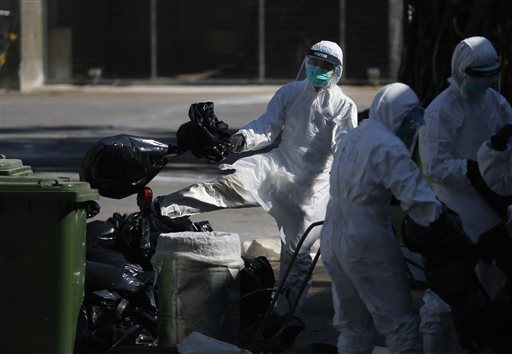
A health worker in full protective gear throws killed chickens in a plastic bag at a wholesale poultry market in Hong Kong, Wednesday, Dec. 31, 2014. Authorities in Hong Kong have begun destroying 15,000 chickens at a poultry market and suspended imports from mainland China after bird flu was found in some birds. (AP Photo/Kin Cheung)(AP Photo/Kin Cheung)
HONG KONG — Authorities in Hong Kong began destroying 15,000 chickens at a poultry market Wednesday and suspended imports from mainland China after some birds were found to be infected with bird flu.
The market in Cheung Sha Wan in the Kowloon district will be closed and imports suspended for 21 days, Health Secretary Ko Wing-man announced.
Some chickens at the market supplied by a farm in Guangdong province on the mainland tested positive for the H7 variety of flu, Ko said. Authorities are most concerned about preventing the spread of the H7N9 strain, but Ko gave no indication whether that was found.
Authorities will “arrange to cull all the live poultry, around 15,000 in total” at the market, Ko said at a news conference early Wednesday, according to a transcript distributed by his agency.
“Supply of live poultry from the mainland will also have to be suspended for the same period of time,” Ko said.
On Tuesday, the Hong Kong government announced that tests showed some birds from the farm in Huizhou in Guangdong were infected at some time in the past with the H7 flu.
Ko said another round of tests confirmed the birds were still infected.
In January, Hong Kong authorities destroyed 20,000 birds after a chicken from Guangdong tested positive for the H7N9 flu strain.